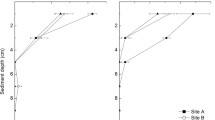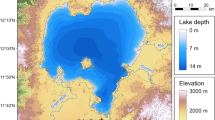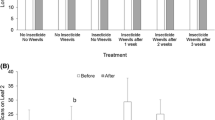Abstract
Lakes have an esthetic significance that is particularly important for attracting tourism. In this context, it is often preferable for lakes to have clear water, so many lake managers attempt to achieve clear lake water by various means. However, the lakes of Kashmir Himalaya are undergoing several complex ecological changes due to, for example, increasing tourism, overfishing, and intensive agriculture, which are making these lakes less clear. One such change is the vigorous growth and development of aquatic weeds in the shallow-water areas of Kashmir Himalayan lakes. We thus, investigated the response of Nymphoides peltatum, a rapidly multiplying clonal species, to water depth, in order to determine whether water depth can be used to control the spread of this proliferating macrophyte. Different traits of the given plant species, such as the mean number of ramets, were significantly higher (F = 55.412, p = 0.000) at depth zone D1 (0–100 cm) than at depth zones D2 (101–200 cm) and D3 (201–300 cm). In all of the lakes, mean spacer length—a tool for facilitating plant spread—was observed to be significantly higher (F = 45.890, p = 0.000) at lower water levels (0–100 cm). Also, the reproductive structures (flowers) of N. peltatum showed significant variation with depth (F = 51.909, p = 0.000) and with the lake examined (F = 9.909, p = 0.001). Thus, the results obtained during the present study indicate the importance of water depth in the management of N. peltatum in various Kashmir Himalayan lakes.








Similar content being viewed by others
References
Armstrong W, Brandle R, Jackson MB (1994) Mechanisms of flood tolerance in plants. Acta Bot Neerl 43:307–358
Asaeda T, KienTrung V, Manatunge J (2000) Modeling the effects of macrophyte growth and decomposition on the nutrient budget in shallow lakes. Aquat Bot 68:217–237
Badar B, Romshoo SA, Khan MA (2013) Integrating biophysical and socioeconomic information for prioritizing watersheds in a Kashmir Himalayan lake: a remote sensing and GIS approach. Environ Monit Assess 185:6419–6445
Baldwin AH, Egnotovich MS, Clarke E (2001) Hydrologic change and vegetation of tidal freshwater marshes: field, greenhouse, and seed-bank experiments. Wetlands 21:519–532
Blanch SJ, Ganf GG, Walker KF (1999) Tolerance of riverine plants to flooding and exposure indicated by water regime. Regul Rivers: Res Manag 15:43–62
Bloom AJ, Chapin FS, Mooney HA (1985) Resource limitation in plants—an economic analogy. Annu Rev Ecol Syst 16:363–392
Cain ML (1994) Consequences of foraging in clonal plant species. Ecology 75:933–944
Casanova MT, Brock MA (2000) How do depth, duration and frequency of flooding influence the establishment of wetland plant communities? Plant Ecol 147:237–250
Clevering OA, Hundscheid MPJ (1998) Plastic and non-plastic variation in growth of newly established clones of Scirpus (Bolboschoenus) maritimus L. grown at different water depths. Aquat Bot 62:1–17
Cole CA, Brooks RP (2000) Patterns of wetland hydrology in the Ridge and Valley Province, Pennsylvania, USA. Wetlands 20(3):438–447
Cooke GD, Welch EB, Peterson SA, Newroth PR (1993) Restoration and management of lakes and reservoirs, 2nd edn. Lewis, New York
Coops H, Hosper SH (2002) Water-level management as a tool for the restoration of shallow lakes in the Netherlands. Lake Res Manag 18:293–298
Coops H, Van den Brink FWB, Van der Velde G (1996) Growth and morphological responses of four helophytes species in an experimental water-depth gradient. Aquat Bot 54:11–24
de Kroon H, Hutchings MJ (1995) Morphological plasticity in clonal plants: the foraging concept revisited. J Ecol 83:143–152
De Steven D, Toner MM (2004) Vegetation of upper coastal plain depression wetlands: environmental templates and wetland dynamics within a landscape framework. Wetlands 24:23–42
Ellison AM, Bedford BL (1995) Response of a wetland vascular plant community to disturbance: a simulation study. Ecol Appl 5(1):109–123
Givnish TJ (1987) Comparative studies of leaf form: assessing the relative roles of selective pressures and phylogenetic constraints. New Phytol 106:131–160
Groeneveld HW, Voesenek LACJ (2003) Submergence-induced petiole elongation in Rumex palustris is controlled by developmental stage and storage compounds. Plant Soil 253:115–123
Grosse W, Jovy K, Tiebel H (1996) Influence of plants on redox potential and methane production in water-saturated soil. Hydrobiologia 340:93–99
Hofmann H, Lorke A, Peeters F (2008) Temporal scales of water-level fluctuations in lakes and their ecological implications. Hydrobiologia 613:85–96
Jeppesen E, Meerhoff M, Jacobsen BA, Hansen RS, Søndergaard M, Jensen JP, Lauridsen TL, Mazzeo N, Branco CWC (2007) Restoration of shallow lakes by nutrient control and bio-manipulation—the successful strategy varies with lake size and climate. Hydrobiologia 581:269–285
Johnson WC, Boettcher SE, Poiani KA, Guntenspergen G (2004) Influence of weather extremes on the water levels of glaciated prairie wetlands. Wetlands 24:385–398
Keddy PA (2000) Wetland ecology: principles and conservation. Cambridge University Press, Cambridge
Khanday SA, Yousuf AR, Reshi ZA, Jehangir A (2015a) Distribution pattern of rooted floating leaf type macrophytes in response to water depth in a fresh water lake of Kashmir Himalaya. J Ecosyst Ecograph 5:159
Khanday SA, Yousuf AR, Reshi ZA, Jehangir A, Rashid I (2015b) The influence of water depth on morphological traits of Trapa natans in Valley lakes of Kashmir. J Himalaya Ecol Sustain Dev 10:39–46
Milne JM, Murphy KJ, Thomaz SM (2006) Morphological variation in Eichhornia azurea (Kunth) and Eichhornia crassipes (Mart.) Solms in relation to aquatic vegetation type and the environment in the floodplain of the Rio Parana, Brazil. Hydrobiologia 570:19–25
Mushtaq B, Raina R, Wanganeo A, Yousuf R, Jehangir A (2014) Variations in macrozoobenthos communities with deweeding operations in Nishat Basin of Dal Lake Srinagar, Kashmir. Am Int J Contemp Sci Res 1(3)
Oborny B, Cain ML (1997) Models of spatial spread and foraging in clonal plants. The ecology and evolution of clonal plants. Backhuys, Leiden, pp 155–183
Paillisson JM, Marion L (2011) Water level fluctuations for managing excessive plant biomass in shallow lakes. Ecol Eng 37:241–247
Rea N, Ganf GG (1994) Water depth changes and biomass allocation in two contrasting macrophytes. Aust J Mar Fresh Water 45:1459–1468
Ridge IR, Amarsinghe I (1984) Ethylene and growth control in the fringed waterlily (Nymphoides peltata): stimulation of cell division and interaction with buoyant in petioles. Plant Growth Rugulation. 2:235–249
Scheffer M (1998) Ecology of shallow lakes. Chapman and Hall, London
Shah HB, Yousuf AR, Chishti MZ, Ahmad F (2013) Helminth communities of fish as ecological indicators of lake health. Parasitology 140:352–360
Strand JA, Weisner SEB (2001) Morphological plastic responses to water depth and wave exposure in an aquatic plant (Myriophyllum spicatum). J Ecol 89:166–175
Van der Valk AG (1990) Response of wetland vegetation to a change in water level. In: Finlayson CM, Larsson T (eds) Wetland management and restoration. Proceedings from a workshop in Sweden 1990. SNV Report 3992. Swedish Environmental Protection Agency, Solna, p 7–16
van Nes EH, Scheffer M, van den Berg MS, Coops H (2002) Aquatic macrophytes: restore, eradicate or is there a compromise? Aquat Bot 72:387–403
Vervuren PJA, Cblom WPM, de Kroon H (2003) Extreme flooding events on the Rhine and the survival and distribution of riparian plant species. J Ecol 91:135–146
Vretare V, Weisner SEB, Strand JA, Graneli W (2001) Phenotypic plasticity in Phragmites australis as a functional response to water depth. Aquat Bot 69:127–145
Weiher E, Keddy PA (1995) The assembly of experimental wetland plant communities. Oikos 73:323–335
Wolfer SR, Straife D (2004) Saptio-temporal dynamics and plasticity of clonal architecture in Potamogeton perfoliatus. Aquat Bot 78:307–318
Wu ZH, Yu D, Tu MH, Wang Q, Xiong W (2007) Interference between two floating-leaved aquatic plants: Nymphoides peltata and Trapa bispinosa. Aquat Bot 86:316–320
Xie Y, Ren B, Li F (2009) Increased nutrient supply facilitates acclimation to high-water level in the marsh plant Deyeuxia angustifolia: the response of root morphology. Aquat Bot 91:1–5
Yang Y, Yin X, Chen H, Yang Z (2014) Determining water level management strategies for lake protection at the ecosystem level. Hydrobiologia 738:111. doi:10.1007/s10750-014-1923-4
Yousuf AR (1979) Limnology and fisheries of Manasbal lake. Ph.D thesis. University of Kashmir, Srinagar
Zargar UR, Yousuf AR, Chishti MZ, Ahmed F, Bashir H, Ahmed F (2012) Effects of water quality and trophic status on helminth infections in the cyprinid fish, Schizothorax niger Heckel, 1838 from three lakes in the Kashmir Himalayas. J Helminthol 86:70–76
Author information
Authors and Affiliations
Corresponding author
Additional information
Handling Editor: Tomomi Inoue.
Rights and permissions
About this article
Cite this article
Khanday, S.A., Yousuf, A.R., Reshi, Z.A. et al. Management of Nymphoides peltatum using water level fluctuations in freshwater lakes of Kashmir Himalaya. Limnology 18, 219–231 (2017). https://doi.org/10.1007/s10201-016-0503-x
Received:
Accepted:
Published:
Issue Date:
DOI: https://doi.org/10.1007/s10201-016-0503-x




